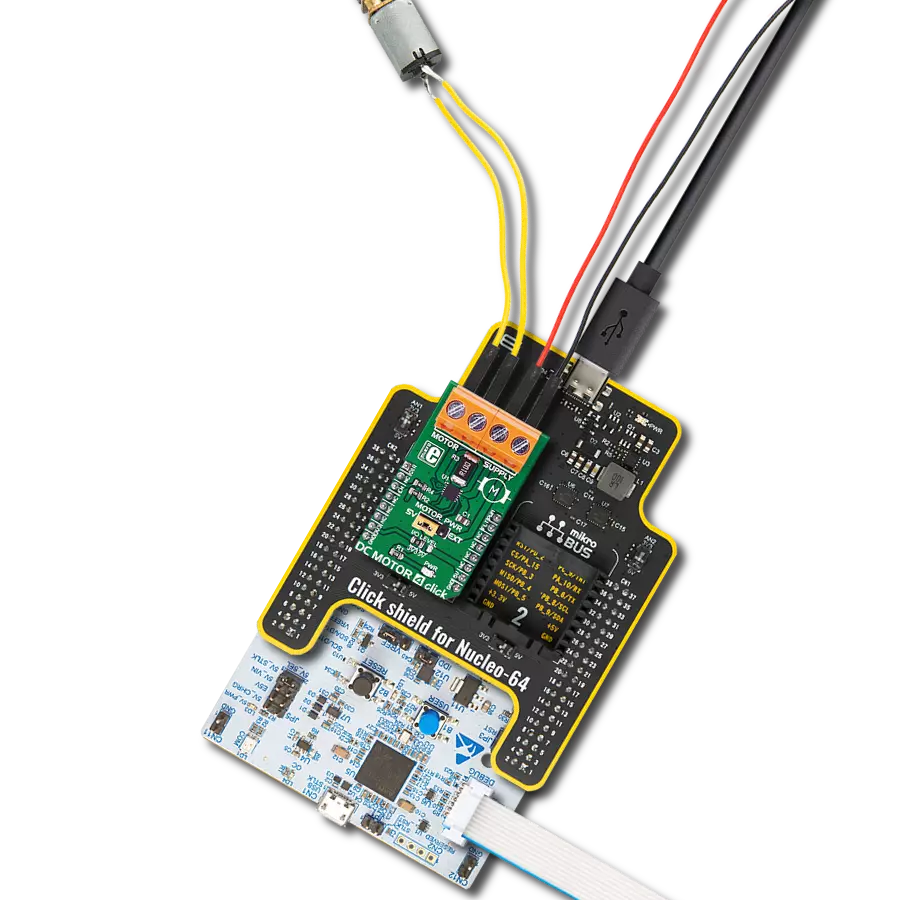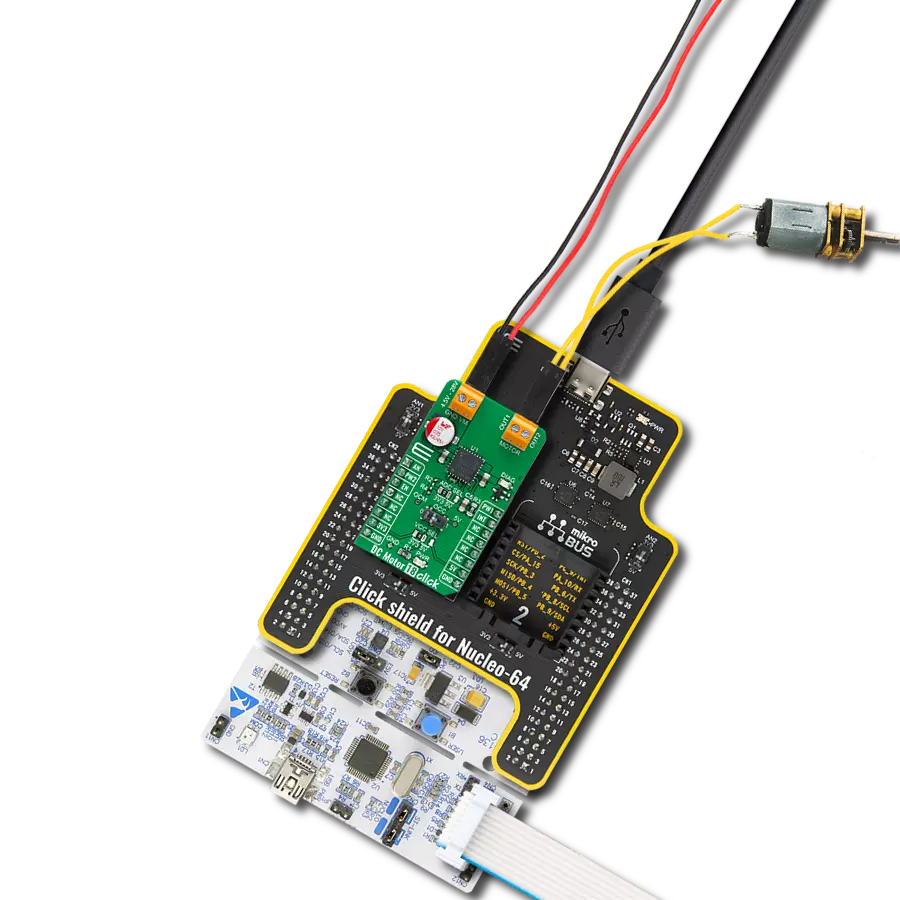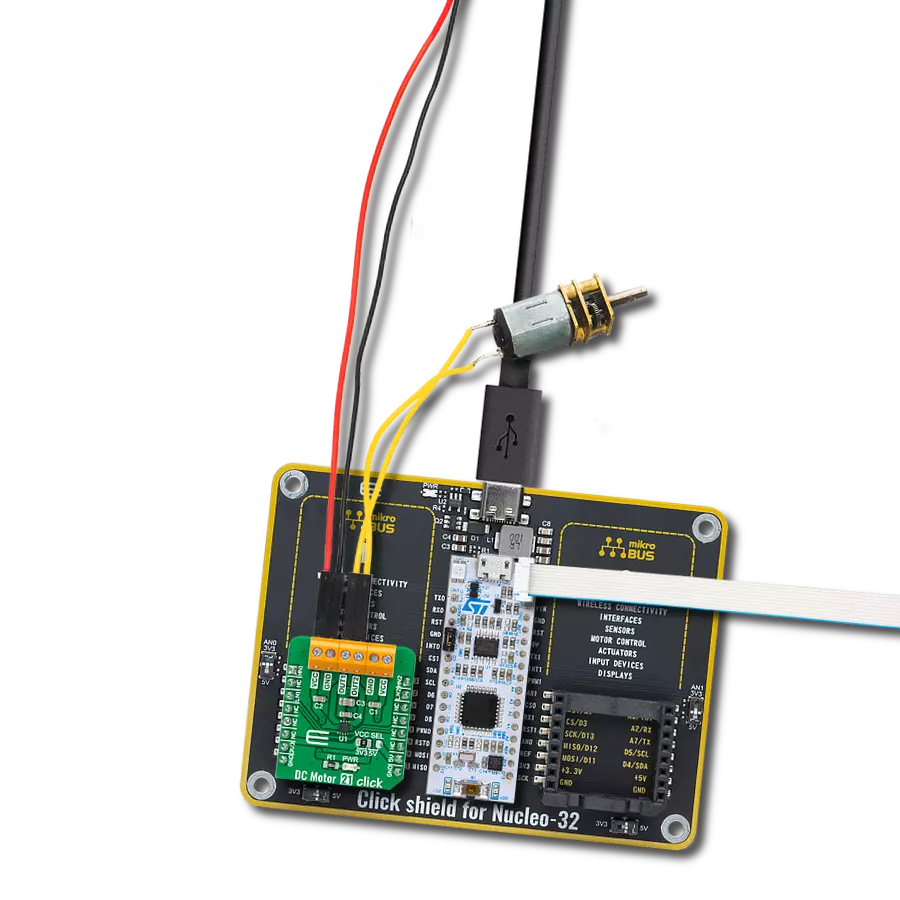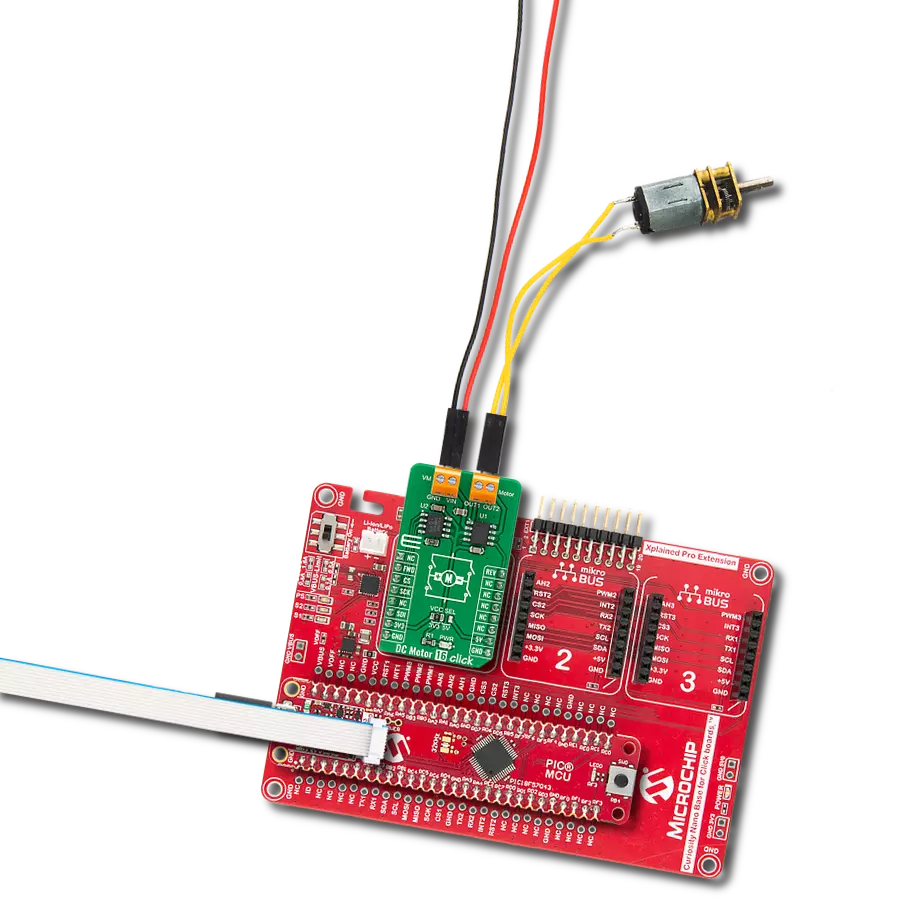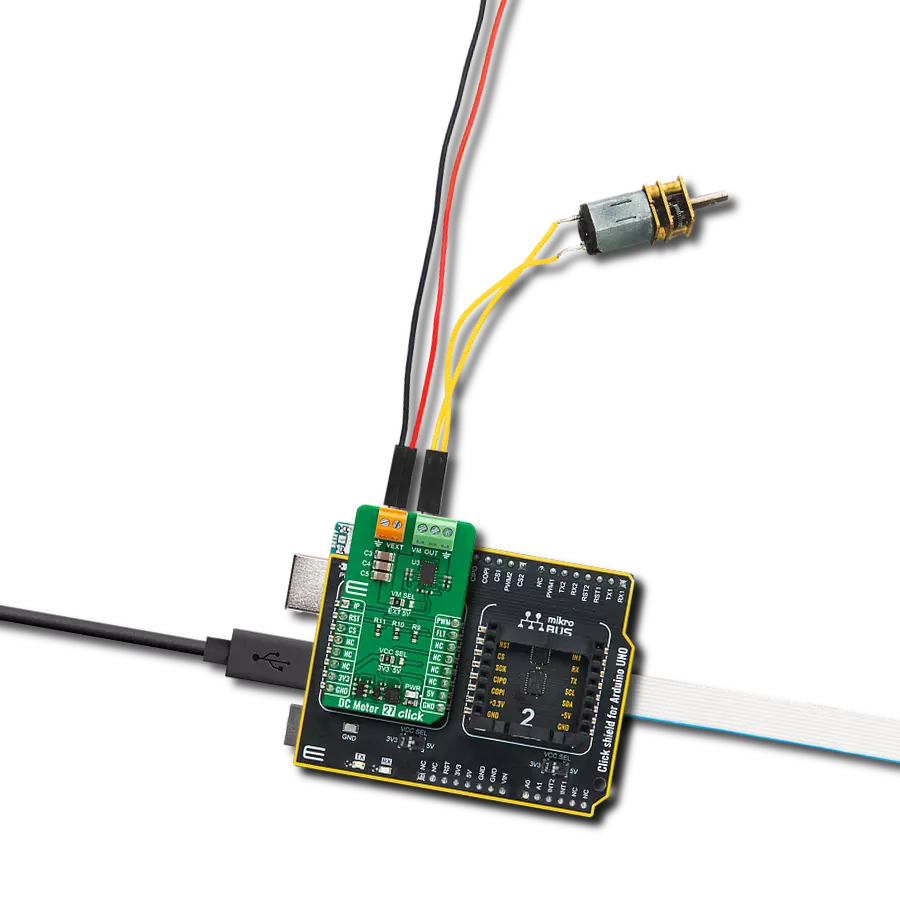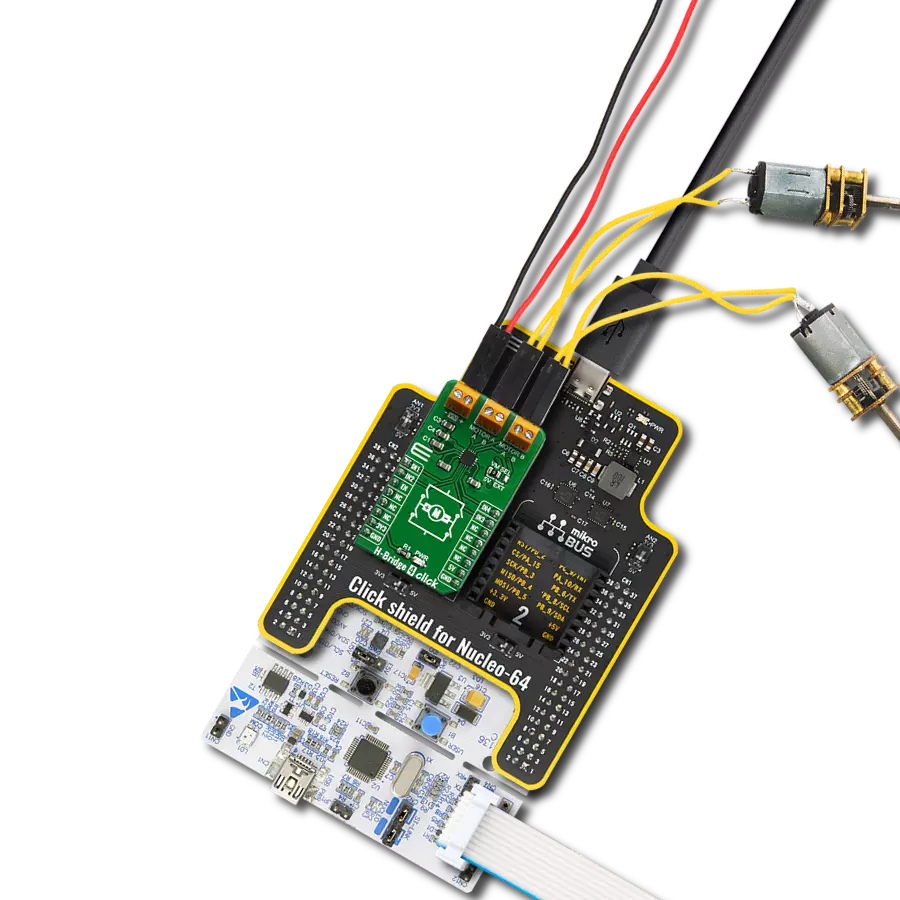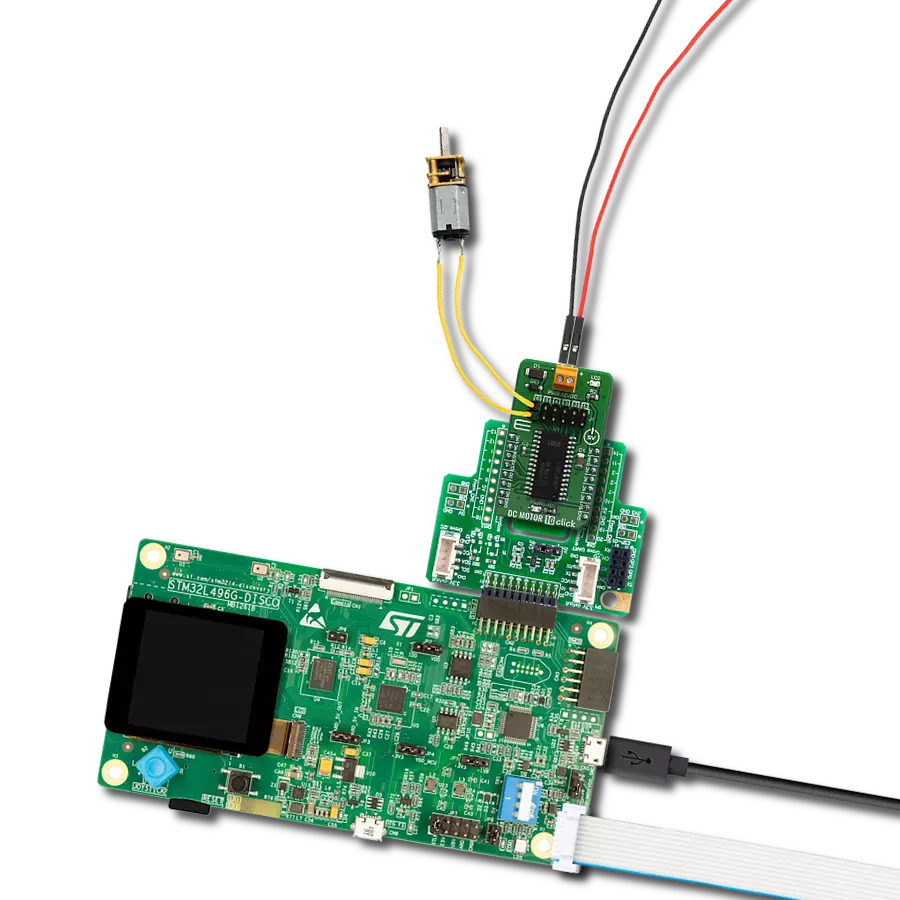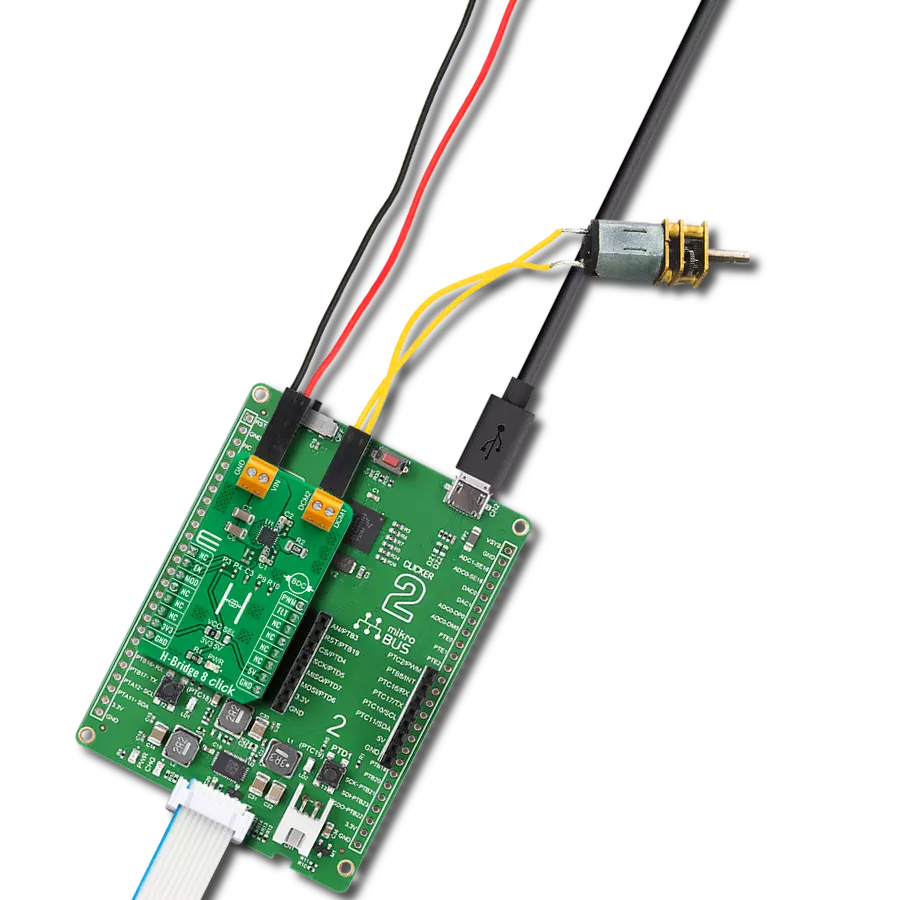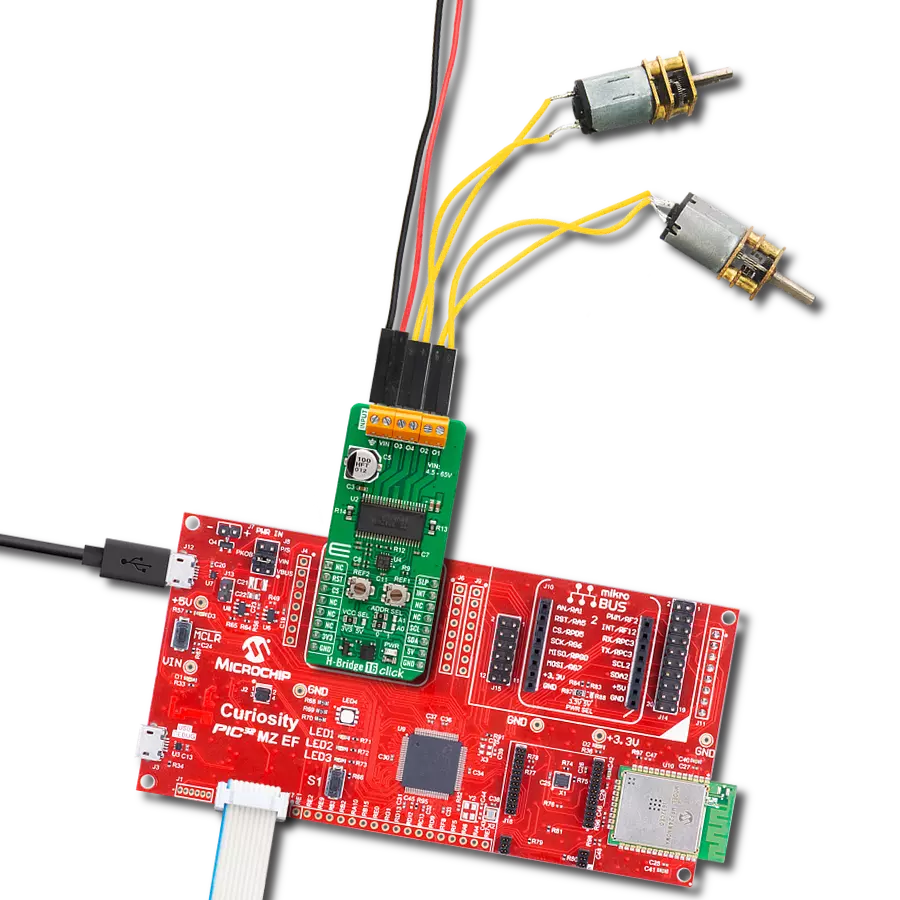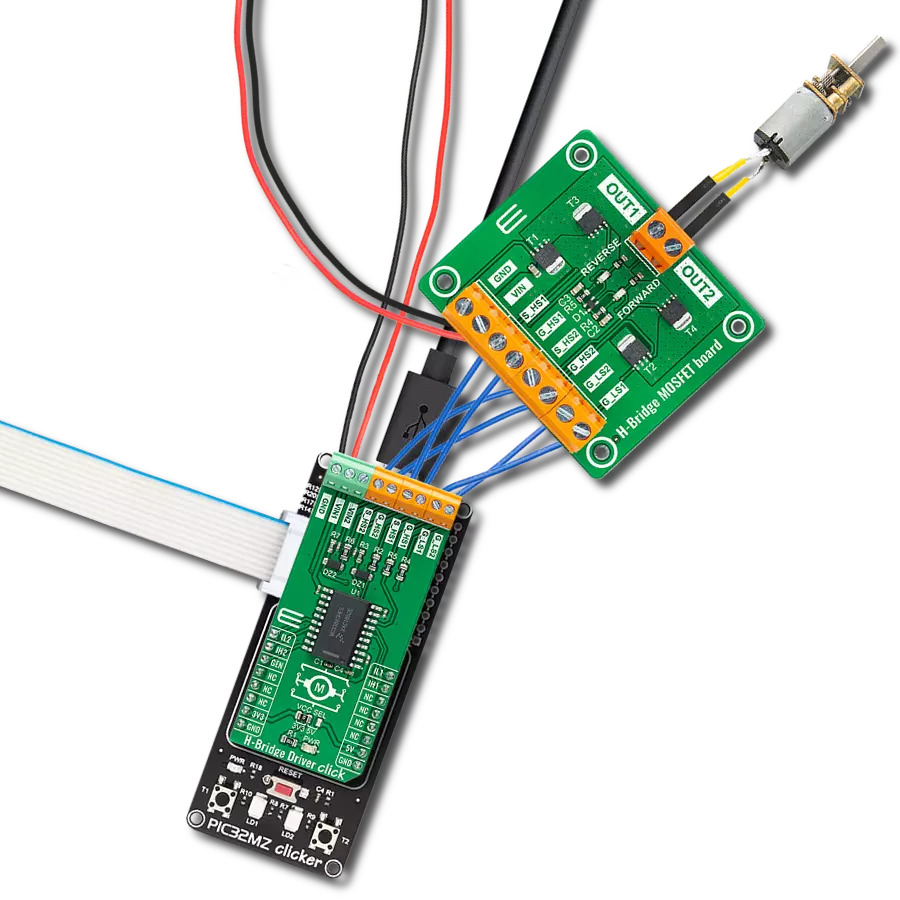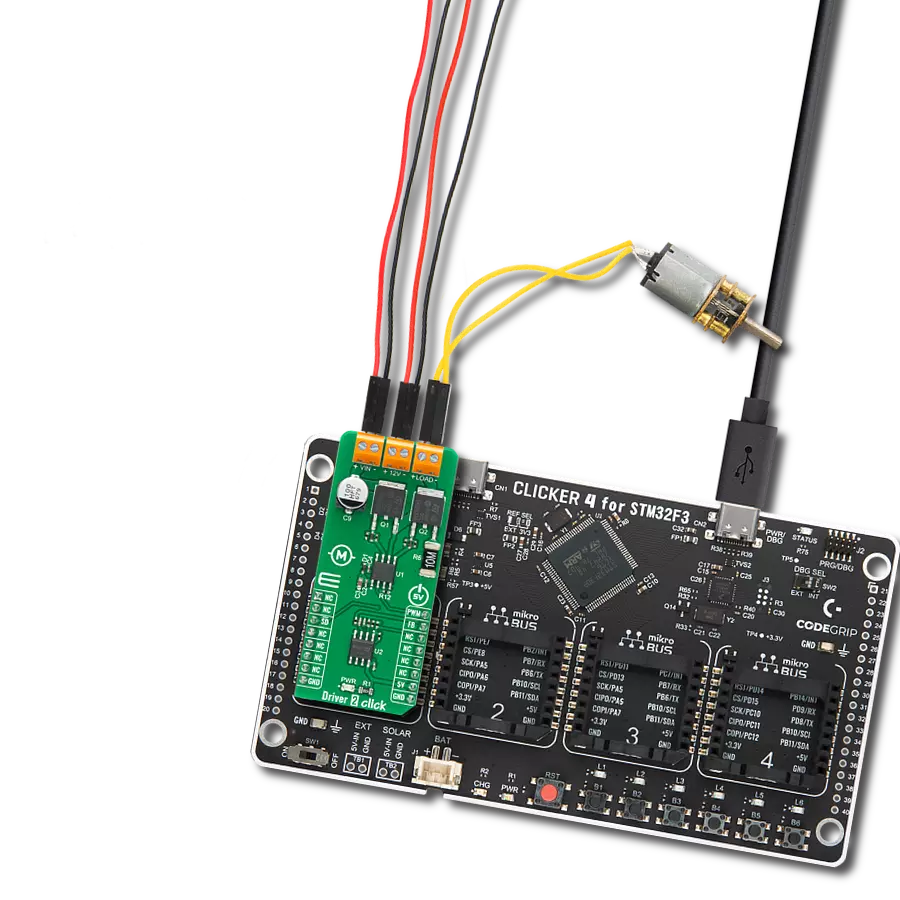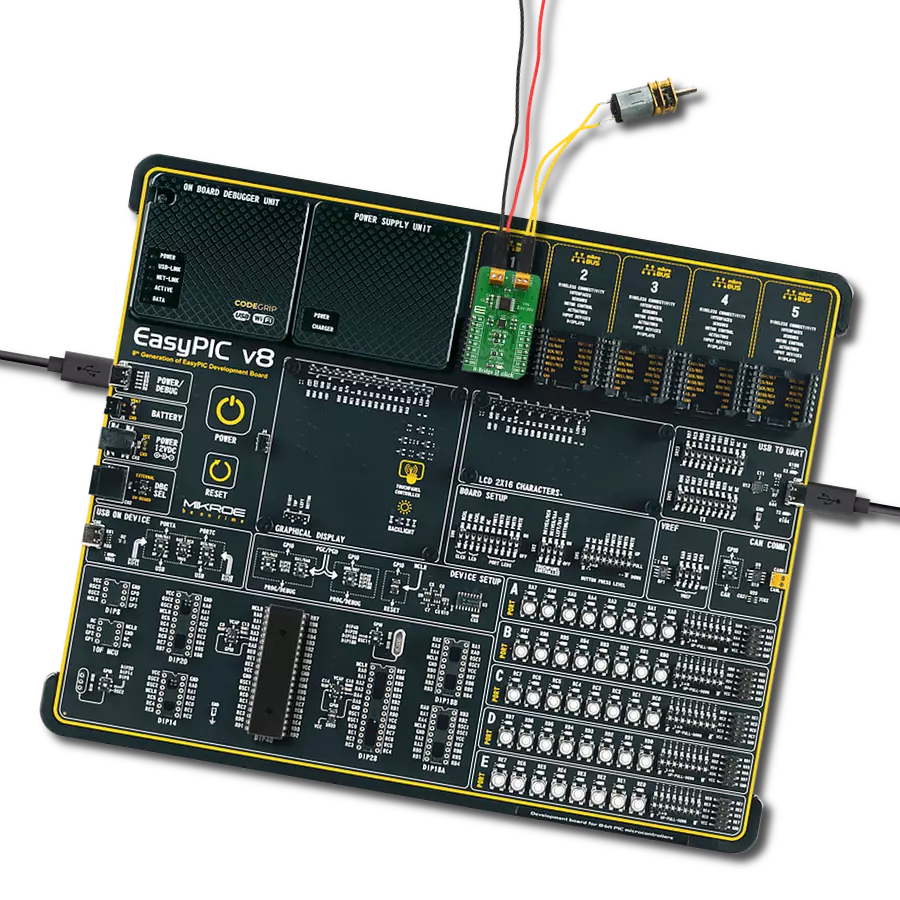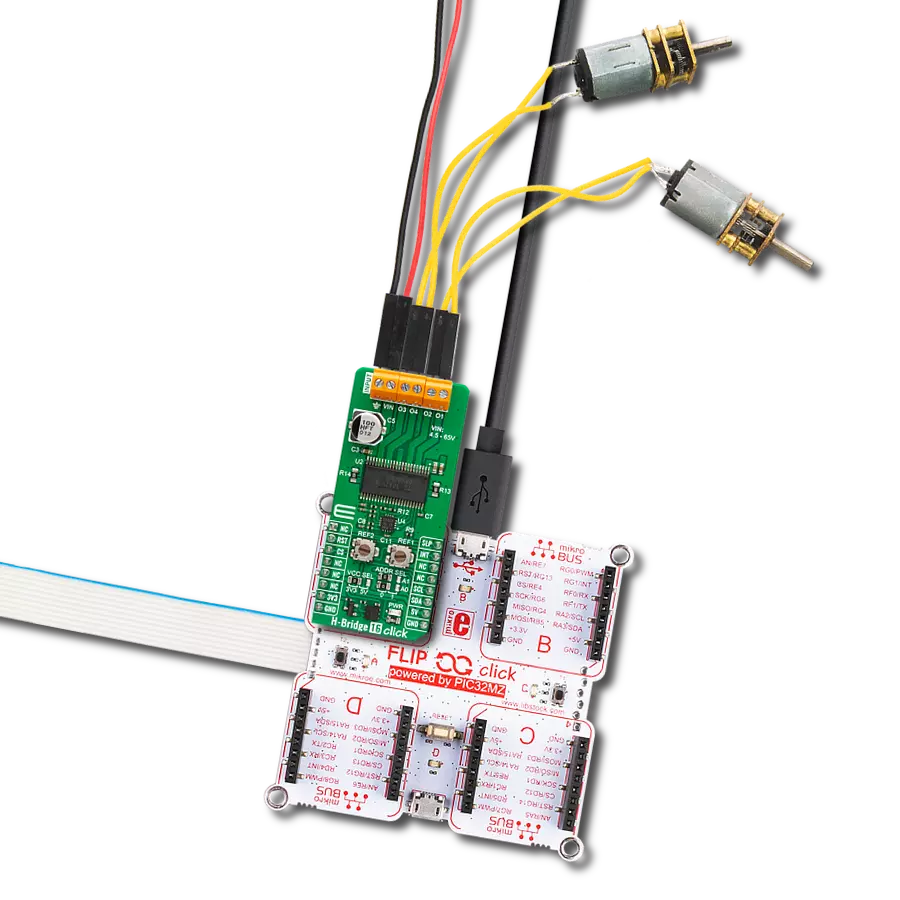Experience the power of integrated motor control. Upgrade your future projects and unlock a new level of excellence!
A
A
Hardware Overview
How does it work?
DC Motor 21 Click is based on the A3910, a dual half-bridge motor driver designed for low voltage power applications from Allegro Microsystems. This Click board™ is controlled via several GPIO pins of the mikroBUS™ socket and has a wide operating voltage range with an output current capacity of 500mA maximum. The integrated MOSFETs, which configure a half-bridge circuit inside the A3910, provide the possibility to drive dual DC motors and allow them to be used in the full-bridge configuration to drive a single bidirectional DC motor. Thanks to its plane features and benefits, this Click board™ is
targeted at the consumer market with end applications to low voltage equipment. Using an integrated MOS switch improves braking action for the motor, compared to implementation with a simple clamp diode. Besides, it also features built-in protection, such as crossover current and thermal shutdown protection, alongside “Sleep” Standby mode with zero drain-current. As mentioned in the product description, DC Motor 21 Click communicates with MCU using several GPIO pins. To turn ON the internal MOSFETs of the A3910, they need to be switched by the logic level, which is input to the control input pins: HN1, LN1,
HN2, and LN2 pins routed to the AN, CS, PWM, and INT pins of the mikroBUS™ socket. The Drive/Break/Coast/Sleep motor functions can be selected according to the state of its input control signals. This Click board™ can operate with either 3.3V or 5V logic voltage levels selected via the VCC SEL jumper. This way, both 3.3V and 5V capable MCUs can use the communication lines properly. The Click board™ comes equipped with a library containing easy-to-use functions and an example code that can be used, as a reference, for further development.
Features overview
Development board
Clicker 2 for Kinetis is a compact starter development board that brings the flexibility of add-on Click boards™ to your favorite microcontroller, making it a perfect starter kit for implementing your ideas. It comes with an onboard 32-bit ARM Cortex-M4F microcontroller, the MK64FN1M0VDC12 from NXP Semiconductors, two mikroBUS™ sockets for Click board™ connectivity, a USB connector, LED indicators, buttons, a JTAG programmer connector, and two 26-pin headers for interfacing with external electronics. Its compact design with clear and easily recognizable silkscreen markings allows you to build gadgets with unique functionalities and
features quickly. Each part of the Clicker 2 for Kinetis development kit contains the components necessary for the most efficient operation of the same board. In addition to the possibility of choosing the Clicker 2 for Kinetis programming method, using a USB HID mikroBootloader or an external mikroProg connector for Kinetis programmer, the Clicker 2 board also includes a clean and regulated power supply module for the development kit. It provides two ways of board-powering; through the USB Micro-B cable, where onboard voltage regulators provide the appropriate voltage levels to each component on the board, or
using a Li-Polymer battery via an onboard battery connector. All communication methods that mikroBUS™ itself supports are on this board, including the well-established mikroBUS™ socket, reset button, and several user-configurable buttons and LED indicators. Clicker 2 for Kinetis is an integral part of the Mikroe ecosystem, allowing you to create a new application in minutes. Natively supported by Mikroe software tools, it covers many aspects of prototyping thanks to a considerable number of different Click boards™ (over a thousand boards), the number of which is growing every day.
Microcontroller Overview
MCU Card / MCU
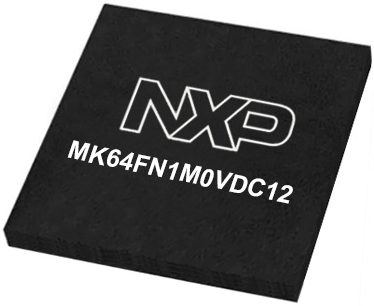
Architecture
ARM Cortex-M4
MCU Memory (KB)
1024
Silicon Vendor
NXP
Pin count
121
RAM (Bytes)
262144
You complete me!
Accessories
DC Gear Motor - 430RPM (3-6V) represents an all-in-one combination of a motor and gearbox, where the addition of gear leads to a reduction of motor speed while increasing the torque output. This gear motor has a spur gearbox, making it a highly reliable solution for applications with lower torque and speed requirements. The most critical parameters for gear motors are speed, torque, and efficiency, which are, in this case, 520RPM with no load and 430RPM at maximum efficiency, alongside a current of 60mA and a torque of 50g.cm. Rated for a 3-6V operational voltage range and clockwise/counterclockwise rotation direction, this motor represents an excellent solution for many functions initially performed by brushed DC motors in robotics, medical equipment, electric door locks, and much more.
Used MCU Pins
mikroBUS™ mapper
Take a closer look
Click board™ Schematic
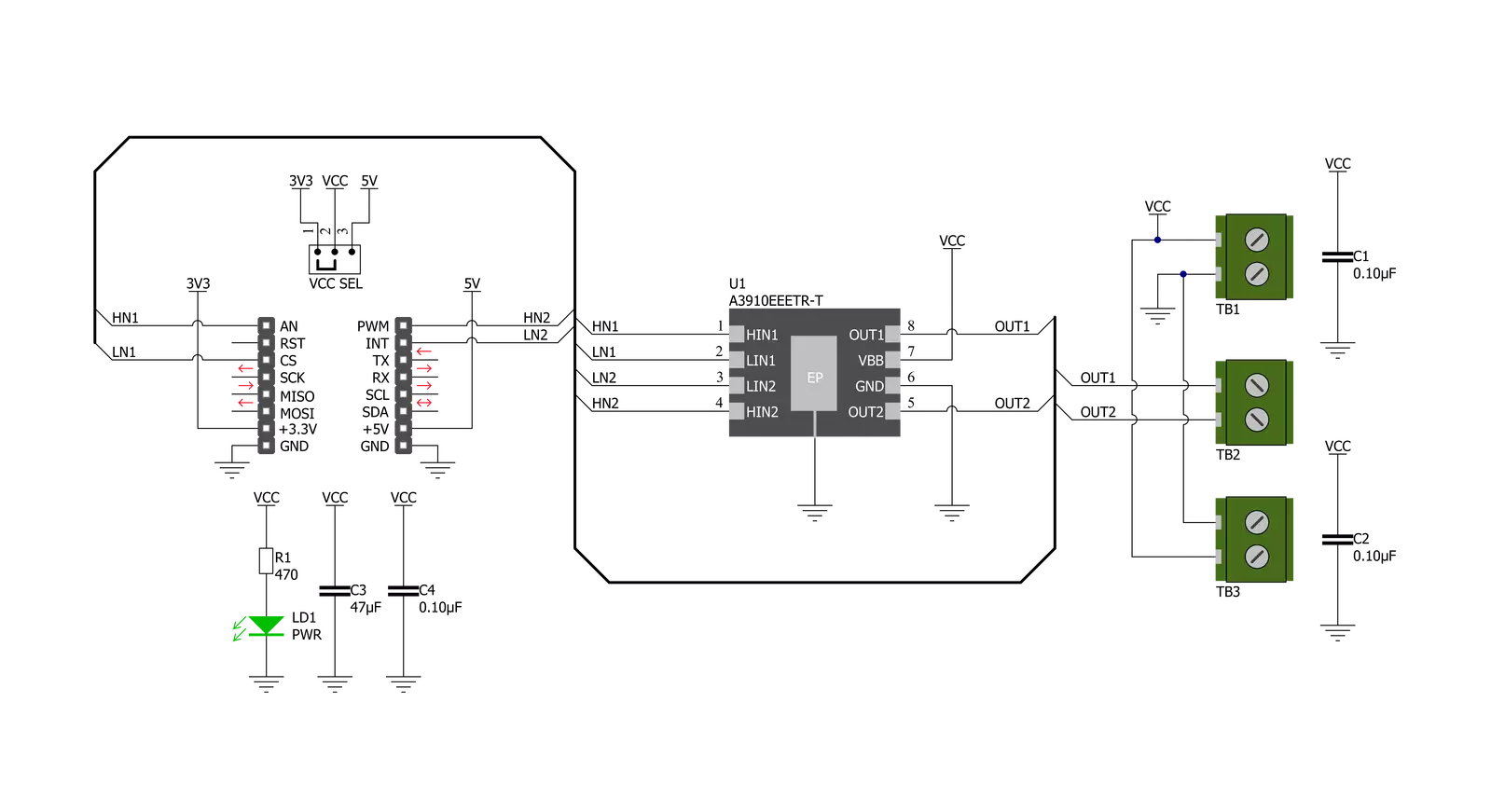
Step by step
Project assembly
Software Support
Library Description
This library contains API for DC Motor 21 Click driver.
Key functions:
dcmotor21_set_out_1- This function sets the state of output 1dcmotor21_set_out_2- This function sets the state of output 2
Open Source
Code example
The complete application code and a ready-to-use project are available through the NECTO Studio Package Manager for direct installation in the NECTO Studio. The application code can also be found on the MIKROE GitHub account.
/*!
* @file main.c
* @brief DC Motor 21 Click Example.
*
* # Description
* This example demonstrates the use of DC Motor 21 Click board.
*
* The demo application is composed of two sections :
*
* ## Application Init
* Initializes the driver and performs the Click default configuration.
*
* ## Application Task
* In the span of six seconds, it drives the motor in one direction, then switches the direction,
* and after that disconnects the motor. Each step will be logged on the USB UART where
* you can track the program flow.
*
* @note
* For this example, a DC motor should be connected to OUT1 and OUT2 lines.
*
* @author Stefan Filipovic
*
*/
#include "board.h"
#include "log.h"
#include "dcmotor21.h"
static dcmotor21_t dcmotor21; /**< DC Motor 21 Click driver object. */
static log_t logger; /**< Logger object. */
void application_init ( void )
{
log_cfg_t log_cfg; /**< Logger config object. */
dcmotor21_cfg_t dcmotor21_cfg; /**< Click config object. */
/**
* Logger initialization.
* Default baud rate: 115200
* Default log level: LOG_LEVEL_DEBUG
* @note If USB_UART_RX and USB_UART_TX
* are defined as HAL_PIN_NC, you will
* need to define them manually for log to work.
* See @b LOG_MAP_USB_UART macro definition for detailed explanation.
*/
LOG_MAP_USB_UART( log_cfg );
log_init( &logger, &log_cfg );
log_info( &logger, " Application Init " );
// Click initialization.
dcmotor21_cfg_setup( &dcmotor21_cfg );
DCMOTOR21_MAP_MIKROBUS( dcmotor21_cfg, MIKROBUS_1 );
if ( DIGITAL_OUT_UNSUPPORTED_PIN == dcmotor21_init( &dcmotor21, &dcmotor21_cfg ) )
{
log_error( &logger, " Communication init." );
for ( ; ; );
}
dcmotor21_default_cfg ( &dcmotor21 );
log_info( &logger, " Application Task " );
}
void application_task ( void )
{
dcmotor21_set_out_1 ( &dcmotor21, DCMOTOR21_OUT_LOW );
dcmotor21_set_out_2 ( &dcmotor21, DCMOTOR21_OUT_HIGH );
log_printf( &logger, " \r\n Driving the motor...\r\n" );
Delay_ms ( 1000 );
Delay_ms ( 1000 );
dcmotor21_set_out_1 ( &dcmotor21, DCMOTOR21_OUT_HIGH );
dcmotor21_set_out_2 ( &dcmotor21, DCMOTOR21_OUT_LOW );
log_printf( &logger, " Switch direction.\r\n" );
Delay_ms ( 1000 );
Delay_ms ( 1000 );
dcmotor21_set_out_1 ( &dcmotor21, DCMOTOR21_OUT_HIGH_Z );
dcmotor21_set_out_2 ( &dcmotor21, DCMOTOR21_OUT_HIGH_Z );
log_printf( &logger, " The motor is disconnected.\r\n" );
Delay_ms ( 1000 );
Delay_ms ( 1000 );
}
int main ( void )
{
/* Do not remove this line or clock might not be set correctly. */
#ifdef PREINIT_SUPPORTED
preinit();
#endif
application_init( );
for ( ; ; )
{
application_task( );
}
return 0;
}
// ------------------------------------------------------------------------ END



















